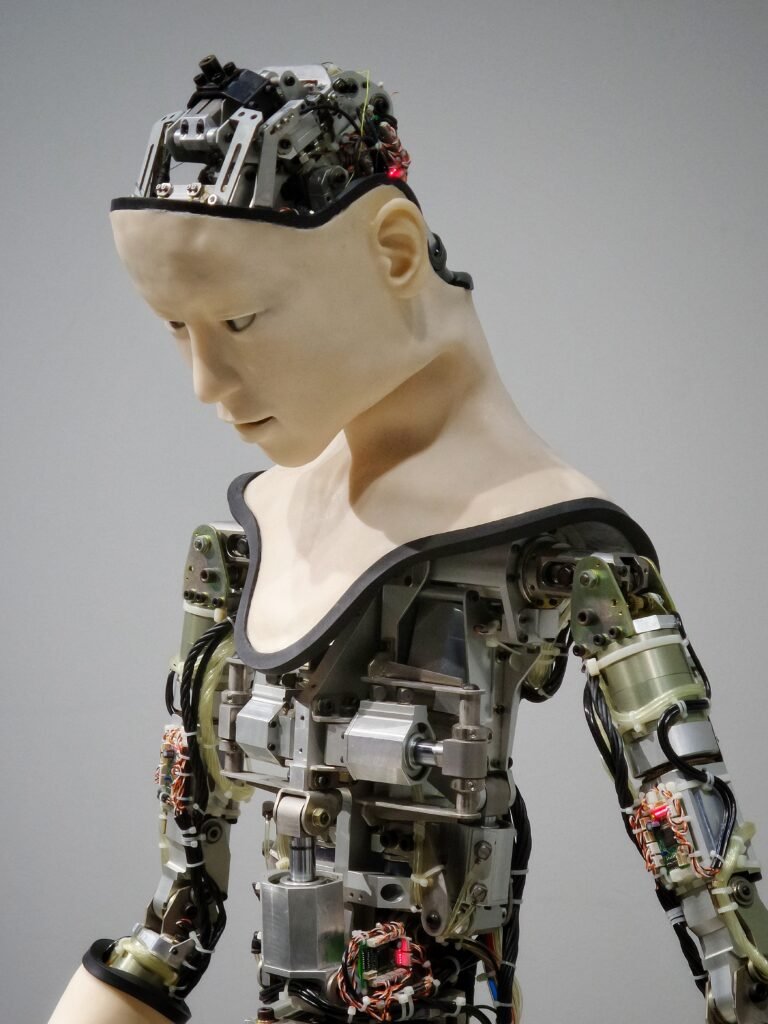Imagine a world where computers have the ability to think, learn, and make decisions just like humans. This is the fascinating realm of artificial intelligence (AI) that is rapidly transforming the way we live, work, and interact with technology. In simple terms, AI refers to machines or computer systems that exhibit intelligence similar to that of human beings. From autonomous cars to virtual assistants, AI has infiltrated various aspects of our lives, making it crucial to understand the profound impact of this ever-evolving technology. So, let’s delve into the realm of AI and explore what exactly defines an artificial intelligence.

Definition of Artificial Intelligence
Artificial Intelligence (AI) is a branch of computer science that focuses on the development of intelligent machines capable of performing tasks that typically require human intelligence. These machines are designed to learn, reason, and problem-solve, allowing them to make decisions and take actions without explicit human intervention. AI systems are built to analyze vast amounts of data, recognize patterns, and adapt their behavior based on new information. By mimicking human cognitive processes, AI aims to replicate or exceed human intelligence in performing complex tasks.
Overview of Artificial Intelligence
Artificial Intelligence can be broadly classified into two main categories: Narrow AI and General AI. Narrow AI, also known as weak AI, is designed to perform a specific task or a set of tasks. It is highly specialized and has a limited scope of functionality. On the other hand, General AI, or strong AI, refers to machines that possess the ability to understand, learn, and apply knowledge across various domains, just like a human being.
Historical Development of Artificial Intelligence
The concept of AI dates back to the 1950s when the field was first introduced by computer scientist John McCarthy. Since then, AI has evolved significantly, driven by advancements in computing power, availability of large datasets, and breakthroughs in algorithms. Early AI systems were based on rule-based programming and expert systems, which relied on predefined rules and knowledge. However, as technology advanced, machine learning algorithms emerged, allowing AI systems to learn from data and improve their performance over time.
Key Concepts of Artificial Intelligence
Several key concepts form the foundation of artificial intelligence. One of the fundamental concepts is that of machine learning, which enables AI systems to improve their performance through experience and data analysis. Supervised learning, unsupervised learning, and reinforcement learning are the three main types of machine learning approaches. Another concept is that of deep learning, which involves the use of neural networks to simulate human brain functions, enabling AI systems to handle complex patterns and representations. Furthermore, ethical considerations, such as job displacement, privacy concerns, and bias and fairness issues, play a crucial role in the development and application of AI systems.
Types of Artificial Intelligence
Strong AI vs. Weak AI
Strong AI, often referred to as General AI, refers to machines that possess human-level intelligence and are capable of understanding, reasoning, and solving problems across various domains. These machines have the ability to think and learn autonomously, essentially simulating human cognitive abilities. However, Strong AI is still a theoretical concept and has not yet been realized.
In contrast, Weak AI, also known as Narrow AI, refers to AI systems that are designed to perform specific tasks or functions. These systems are specialized and excel within a narrow range of capabilities. Weak AI is widely used today, powering applications such as virtual personal assistants, recommendation systems, and image recognition algorithms. While performing admirably in their respective domains, these systems lack the broader understanding and general intelligence possessed by humans.
Narrow AI vs. General AI
Narrow AI is designed to excel in specific tasks or domains and is trained extensively to master those particular tasks. It operates within predefined boundaries and cannot generalize beyond its trained scope. Narrow AI systems, such as voice assistants or image recognition algorithms, are optimized for performing these specific tasks efficiently.
In contrast, General AI aims to possess human-level cognitive abilities and understand and perform tasks across diverse domains. General AI systems would possess generalized intelligence, allowing them to adapt and learn quickly in unfamiliar situations. However, the development of General AI is still ongoing, and researchers continue to explore the complexities and challenges involved in replicating human-level intelligence.
Reactive Machines
Reactive machine AI systems are designed to act in response to specific situations or stimuli, without having any memory or past experiences. These systems operate solely in the present, analyzing the current state and responding based on that information. Reactive AI systems do not have the ability to learn from past experiences or adapt their behavior over time.
Limited Memory
Limited memory AI systems, as the name suggests, have the ability to retain some information from the past. They can store and recall specific data to aid decision-making and problem-solving. These systems rely on past experiences to improve their future performance, allowing them to adapt and make more informed choices.
Theory of Mind
The Theory of Mind refers to the ability of an AI system to understand and attribute mental states to others, including beliefs, desires, and intentions. This concept aims to replicate the human capacity to infer and reason about the intentions and beliefs of others. While humans possess Theory of Mind naturally, developing this capability in AI systems remains a significant challenge.
Applications of Artificial Intelligence
Virtual Personal Assistants
Virtual Personal Assistants, such as Apple’s Siri, Amazon’s Alexa, and Google Assistant, are AI-powered applications that simulate human conversation and assist users with tasks such as setting reminders, providing information, and organizing schedules. These assistants use natural language processing and machine learning algorithms to understand and respond to user queries with accurate and relevant information.
Smart Home Devices
Smart home devices, such as voice-controlled speakers and smart thermostats, utilize AI technology to automate various aspects of household management. These devices learn user preferences and patterns over time, enabling them to adjust settings, control other devices, and enhance energy efficiency. AI-powered smart home devices offer increased convenience and improved energy management.
Autonomous Vehicles
Autonomous vehicles, also known as self-driving cars, rely heavily on AI technology to navigate, perceive their environment, and make real-time driving decisions. These vehicles use a combination of sensors, cameras, and advanced algorithms to detect and understand their surroundings, ensuring safe and efficient transportation. Autonomous vehicles have the potential to revolutionize transportation systems by reducing accidents, improving traffic flow, and enhancing mobility for all.
Customer Service Chatbots
Customer service chatbots are AI-powered virtual assistants that interact with customers, helping them with various inquiries and support needs. These chatbots leverage natural language processing and machine learning algorithms to understand customer queries and provide accurate and timely responses. By automating routine customer interactions, chatbots enhance efficiency, provide 24/7 support, and improve customer satisfaction.
Healthcare Diagnosis and Treatment
AI applications in healthcare have the potential to improve diagnosis and treatment outcomes. AI systems can analyze patient data, medical records, and research articles to assist healthcare professionals in diagnosing diseases, suggesting treatments, and predicting patient outcomes. By harnessing the power of AI, healthcare providers can enhance diagnostic accuracy, personalize treatment plans, and improve patient care.
Automated Trading Systems
Automated trading systems, also known as algorithmic trading or robo-trading, rely on AI algorithms to analyze financial market data, identify patterns, and execute trades. These AI-powered systems enable traders to automate their trading strategies, react to market conditions in real-time, and execute trades at high speeds. Automated trading systems have the potential to increase trading efficiency, reduce human error, and optimize investment returns.
Machine Learning and Artificial Intelligence
Understanding Machine Learning
Machine learning is a subfield of AI that focuses on the development of algorithms and models that allow computer systems to learn from data. Instead of explicitly programming rules and instructions, machine learning algorithms learn patterns and relationships in the data through training. This enables systems to make predictions, classify information, and derive insights without explicit human intervention.
Supervised Learning
Supervised learning is a popular approach in machine learning, where the algorithm learns from labeled examples or datasets. The algorithm is provided with input data and corresponding output labels, allowing it to identify patterns and relationships. The goal of supervised learning is to enable the algorithm to predict correct output labels when provided with new input data.
Unsupervised Learning
Unsupervised learning is another approach in machine learning, where the algorithm learns patterns and relationships in unlabeled datasets. Unlike supervised learning, unsupervised learning algorithms do not have access to output labels. Instead, they identify inherent patterns and structures in the data, allowing them to group similar data points or discover hidden patterns.
Reinforcement Learning
Reinforcement learning is a type of machine learning where an agent learns to interact with an environment and optimize its behavior through trial and error. The agent receives feedback from the environment in the form of rewards or penalties, enabling it to learn the optimal actions to maximize rewards. Reinforcement learning is often used in scenarios where there is a need for sequential decision-making or in complex control systems.

Deep Learning and Artificial Intelligence
Defining Deep Learning
Deep learning is a subfield of machine learning that focuses on the development and implementation of artificial neural networks, inspired by the structure and function of the human brain. These deep neural networks learn hierarchical representations and transformations of data, enabling them to handle complex patterns and relationships. Deep learning has achieved remarkable success in various domains, including computer vision, natural language processing, and speech recognition.
Artificial Neural Networks
Artificial Neural Networks (ANNs) are the basic building blocks of deep learning. They consist of interconnected nodes, known as neurons, organized in layers. Information flows through these interconnected neurons, with each neuron processing and transferring information to the next layer. ANNs can learn from data by adjusting the strengths of connections (weights) between neurons, thus enabling them to recognize and classify patterns.
Convolutional Neural Networks
Convolutional Neural Networks (CNNs) are a specific type of deep neural network primarily used for image and video recognition tasks. CNNs are designed to automatically and adaptively learn spatial hierarchies of features, capturing both low-level and high-level visual information. CNNs utilize convolutional layers, pooling layers, and fully connected layers to process images and extract relevant features.
Recurrent Neural Networks
Recurrent Neural Networks (RNNs) are another type of deep neural network that are particularly suited for sequential data, such as text or speech. RNNs are capable of capturing dependencies and temporal relationships in data by using feedback connections. This enables RNNs to handle sequential information and tasks such as language modeling, speech recognition, and machine translation.
Ethical Considerations in Artificial Intelligence
Job Displacement
One of the primary ethical considerations in AI is the potential impact on job displacement. As AI systems become more advanced and automation increases, certain tasks and jobs may be taken over by machines, leading to workforce disruption. It is crucial to plan for retraining and reskilling programs to ensure a smooth transition for individuals who may face job displacement.
Privacy Concerns
The growing use of AI and the collection of massive amounts of data raise significant privacy concerns. AI systems often rely on personal data for training and operation. It is essential to establish robust privacy frameworks and regulations to protect individuals’ privacy rights and ensure their data is handled securely and responsibly.
Bias and Fairness Issues
AI systems can be influenced by biases present in the data they are trained on, leading to biased decision-making and outcomes. It is crucial to address bias and fairness issues in AI systems to ensure equitable treatment and minimize discrimination. Careful data collection and unbiased model training can help mitigate these issues.
Transparency and Accountability
Another ethical consideration is the transparency and accountability of AI systems. As AI systems become more complex and autonomous, it may become challenging to understand and explain the reasoning behind their decisions. Ensuring transparency in AI decision-making and establishing accountability mechanisms is necessary to build trust and prevent potential misuse.

Challenges of Artificial Intelligence
Data Accessibility and Quality
One of the significant challenges in AI is the accessibility and quality of data. AI systems heavily rely on large volumes of high-quality data for training and learning. Obtaining representative and diverse data can be a challenge, especially in domains where data collection is time-consuming, expensive, or ethically sensitive. Ensuring data accessibility and quality is crucial for training accurate and reliable AI models.
Algorithmic Bias
Algorithmic bias is another challenge associated with AI systems. Biases present in the data used for training can lead to biased decision-making or perpetuate existing societal biases. Addressing and mitigating algorithmic bias requires careful evaluation of training data, feature selection, and ongoing monitoring of AI systems’ behavior.
Interpretability and Explainability
The lack of interpretability and explainability of AI systems is a significant challenge, particularly in critical domains such as healthcare and finance. Understanding and providing explanations for AI systems’ decisions and outputs are essential for trust, accountability, and legal compliance. Research and development efforts are ongoing to develop techniques and methods for making AI systems more interpretable and explainable.
Regulatory and Legal Challenges
The rapid advancements in AI pose regulatory and legal challenges. The existing legal frameworks may struggle to keep pace with emerging AI technologies, leading to uncertainties and gaps in regulations. Establishing comprehensive and adaptive regulations that address the ethical and societal implications of AI is essential to maximize the benefits and minimize potential risks.
Future of Artificial Intelligence
Advancements in Artificial Intelligence
The future of AI holds exciting possibilities for advancements in technology. Continued improvements in computing power, data availability, and algorithmic innovation will fuel the development of more sophisticated AI systems. We can expect AI systems with enhanced learning capabilities, more accurate decision-making, and improved human-machine interactions.
Impact on Industries and Society
Artificial Intelligence is set to have a profound impact on various industries and society as a whole. From healthcare to transportation, AI promises to revolutionize these sectors by improving efficiency, accuracy, and accessibility. AI-driven automation may lead to significant changes in the workforce, requiring the reevaluation of job roles and the introduction of new skill sets.
Human-AI Collaboration
The future of AI is not about replacing humans but rather enhancing human capabilities through collaboration with AI systems. Human-AI collaboration will allow humans to leverage the strengths of AI, such as data analysis and pattern recognition, while retaining the uniquely human abilities, such as creativity, empathy, and complex decision-making. This collaboration aims to create synergistic partnerships between humans and machines, leading to innovative breakthroughs and improved outcomes.
Ethical and Policy Frameworks
As AI continues to advance and become more prevalent in society, the development of robust ethical and policy frameworks is paramount. These frameworks should address issues such as job displacement, privacy concerns, fairness, and accountability. Collaborative efforts among policymakers, industry leaders, and researchers are necessary to develop inclusive, responsible, and sustainable AI practices.
The Role of Artificial Intelligence in Everyday Life
AI in Social Media
Artificial Intelligence has had a significant impact on social media platforms. AI algorithms are used to personalize content, curate recommendations, detect fake news, and identify hate speech. AI-powered social media filters also help mitigate harmful or inappropriate content, fostering a safer and more engaging social media experience.
AI in Online Shopping
AI is transforming the online shopping experience, making it more personalized and convenient. Recommendation systems use AI algorithms to analyze user data and provide tailored product suggestions. Chatbots and virtual shopping assistants enhance customer support, helping users find products, answer queries, and resolve any issues.
AI in Healthcare
AI applications in healthcare have the potential to transform patient care and medical practices. AI-based diagnostic systems can analyze medical images, patient data, and medical literature to aid in accurate diagnoses and treatment recommendations. AI-powered wearables and monitoring devices can provide real-time health insights and enable remote patient monitoring.
AI in Education
Artificial Intelligence has the potential to revolutionize education by personalizing learning experiences and promoting individualized instruction. AI-powered adaptive learning platforms can analyze student data and tailor educational content to meet each student’s specific needs and learning styles. AI chatbots can also assist in answering student queries and providing immediate feedback.
AI in Entertainment
Artificial Intelligence is playing an increasingly significant role in entertainment, with AI algorithms being used to recommend movies, TV shows, music, and books based on individual preferences. AI-powered animation and visual effects are enhancing the entertainment industry, allowing for realistic simulations and immersive experiences.
Conclusion
Artificial Intelligence has come a long way since its inception, revolutionizing various industries and transforming everyday life. From virtual personal assistants to autonomous vehicles, AI systems are becoming increasingly integrated into our daily routines. However, ethical considerations, such as job displacement and privacy concerns, must be addressed to ensure responsible and inclusive AI development. As AI continues to advance, it is vital to foster human-AI collaboration and establish robust ethical and policy frameworks. By harnessing the potential of AI while addressing its challenges, we can leverage this technology to enhance human capabilities, improve efficiency, and drive positive impact in society.






